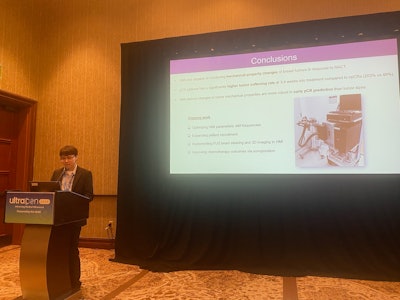AUSTIN -- Harmonic motion imaging can track mechanical property changes of breast tumors in response to neoadjuvant chemotherapy, a study presented April 9 at UltraCon found.
In his presentation, Yangpei Liu from Columbia University in New York City discussed findings from his team’s study, which showed that harmonic motion imaging could be a predictor of early treatment response.
“Harmonic motion imaging-derives changes in tumor mechanical properties are more robust in early complete pathologic response prediction than tumor sizes,” Liu said.
 Yangpei Liu from Columbia University in Ney York City discussed findings at UltraCon suggesting that harmonic motion imaging could be a viable predictor of early treatment response.Amerigo Allegretto
Yangpei Liu from Columbia University in Ney York City discussed findings at UltraCon suggesting that harmonic motion imaging could be a viable predictor of early treatment response.Amerigo Allegretto
Breast imaging researchers have investigated different methods for monitoring tumor response to neoadjuvant chemotherapy to better predict which patients can avoid surgery. Liu said that while dynamic contrast-enhanced MRI, diffusion-weighted imaging, and PET/CT have shown that they can monitor functional tumor biomarkers in large masses, they suffer from low specificity.
Elastography has also been explored in this area, but Liu said that this method is operator-dependent, tumor-size dependent, and relies on shear wave propagation in a locally homogenous region.
Harmonic motion imaging, meanwhile, is an ultrasound-based elasticity imaging technique that uses oscillatory acoustic energy to estimate the mechanical properties of tissues. This also includes monitoring the treatment of tumors.
“There is still a need for a low-cost, non-ionizing, non-invasive imaging technique with high sensitivity and specificity for neoadjuvant chemotherapy response assessment,” Liu said.
The researchers examined the feasibility of harmonic motion imaging in tumor response monitoring during chemotherapy and early prediction of complete pathologic response in breast cancer patients. They used this imaging in eight patients, with three achieving complete pathologic response. The women had an average tumor center depth of 2 cm, with tumor sizes ranging from 1.9 cm to 4.8 cm.
The researchers found that despite high variance in baseline tumor stiffness, women with complete pathologic response experienced a 203% increase in tumor displacement ratio at three weeks of treatment compared to 48% in those who did not achieve complete pathologic response (p < 0.05).
Additionally, the median tumor displacement ratios at two weeks follow-up in the non-complete pathologic response group was 0.14, lower than the 0.2 observed in the complete response group. This suggests that softer tumors are more likely to respond to neoadjuvant chemotherapy.
Two patients completed all three follow-up points, with the third one being four weeks follow-up. One achieved complete pathologic response and had a tumor displacement ratio of 0.55. The second patient did not achieve complete pathologic response and experienced a ratio of 0.06.
Liu suggested that despite the small sample size, the results show harmonic motion imaging’s potential in this area, including its “excellent” agreement between imaging-derived changes and early tumor responses obtained noninvasively. He said that ongoing work includes optimizing the technique and incorporating 3D imaging using a low-power array.



















